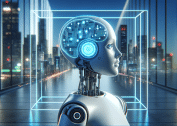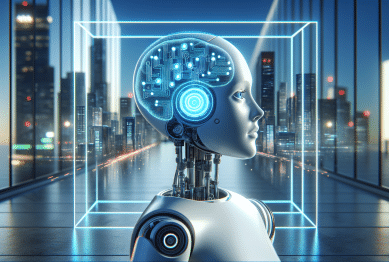Artificial intelligence has quietly woven itself into the devices and services many use every day. This guide explores the surprising ways AI impacts personal tech, privacy, daily routines, and even job skills, helping you see behind the software curtain and consider fresh perspectives.
Is AI Already Shaping Your Daily Experience?
From smartphone cameras that recognize faces to virtual assistants answering your voice commands, artificial intelligence is no longer a distant concept reserved for science labs. Today, many people interact with AI systems often without realizing it—recommendation engines, targeted ads, and smart home devices all use machine learning to enhance user experiences. This silent integration of artificial intelligence into everyday technology can significantly influence decision-making, privacy, and even habits, suggesting that AI awareness is more important than ever.
AI-powered tools can help simplify search queries, route commutes more efficiently, and even predict what messages you’re likely to answer. Such features are often marketed as improvements in convenience, but their operation raises important questions about transparency and autonomy. For example, when a video streaming service displays suggestions based on your prior viewing, it’s not a human making the choices—it’s a set of sophisticated algorithms tuned to predict behaviors using vast datasets (Source: https://www.nist.gov/artificial-intelligence).
Understanding how much AI is woven into personal tech helps people make better-informed decisions about what they use and how. Recognizing this invisible presence can also shed light on why certain notifications appear or purchases are suggested. As AI becomes more nuanced and sophisticated, keeping track of just where and how it operates continues to be a challenge for individuals hoping to manage their digital lives wisely.
Personal Privacy in the Age of Smart Devices
Smart doorbells, TVs, voice assistants, and wearable health trackers all connect people to a digital ecosystem that leverages artificial intelligence to learn from your behaviors. These smart devices can sometimes collect and analyze personal data, raising privacy concerns. Many consumers may not read lengthy privacy policies, and so remain unaware of the extent to which their habits, routines, and even spoken conversations are being stored or processed in the background (Source: https://www.ftc.gov/news-events/topics/privacy-security).
AI-driven algorithms often require diverse inputs to function optimally, which means they constantly gather new information to improve accuracy. This dynamic is a double-edged sword. On the one hand, it provides services with a smoother, more personal touch. On the other, it creates large inventories of user data that can be vulnerable to unauthorized access or misuse. The mere act of using a smart thermostat or a fitness tracker means contributing to ongoing datasets that help refine predictive AI models.
For users, this reality highlights the value of knowing how to manage device settings and understand what data is collected. Privacy and security settings exist for a reason: with a few simple changes, users can decide what information devices retain, transmit, or delete. Staying current with security updates and reviewing permissions regularly can significantly reduce unintended data leaks, helping people gain back a sense of control in an AI-heavy home environment.
Can AI Change the Way You Work and Learn?
Artificial intelligence is not confined to consumer gadgets; it also streams into workplaces and classrooms. Cloud-based office suites, email spam filters, and learning management systems now rely on machine learning to flag suspicious emails, automate repetitive tasks, and personalize content delivery. In many offices, AI is quietly reviewing resumes, optimizing meeting schedules, or analyzing employee productivity. Meanwhile, education technology utilizes predictive analytics to suggest study strategies to students or recommend additional practice materials.
This integration of AI into professional and educational environments doesn’t just make operations more efficient—it transforms required skill sets. In many industries, individuals are now expected to have a baseline understanding of how automation and machine learning impact workflows. The rise of AI has sparked a boost in demand for digital literacy, critical thinking, and data analysis skills, prompting many to seek out online courses to keep pace with evolving job requirements (Source: https://www.edx.org/learn/artificial-intelligence).
Learning platforms powered by AI provide adaptive feedback, helping learners of all ages identify their strengths and weaknesses faster. For job seekers, understanding which parts of an application are rated by automated systems can be invaluable. For institution leaders, balancing automation’s efficiency with the need for privacy and fairness in assessment remains an ongoing challenge. As AI silently shapes the work and learning experience, staying informed supports investment in relevant skills for the future.
Behind Every Recommendation: The Power of Machine Learning
People today often wonder why their social feeds show certain posts or why online stores highlight particular items. The answer typically lies in complex AI-powered recommendation engines. These systems harvest vast amounts of user activity, impressions, and preferences, then use them to predict what content or product will most likely catch a user’s interest. Machine learning algorithms drive nearly all major e-commerce, entertainment, and social platforms—constantly analyzing clicks, connections, and duration of views.
The process is far from random. Through supervised and unsupervised learning, algorithms are trained to identify subtle patterns in user preferences, leading to highly tailored digital experiences. While this personalization can save time and expose individuals to novel content, it can also reinforce filter bubbles—narrowing exposure and sometimes leading to echo chambers. Many experts suggest periodically stepping outside one’s customary recommendations to broaden perspective (Source: https://www.brookings.edu/articles/algorithmic-bias-detection-and-mitigation-best-practices-and-policies-to-reduce-consumer-harms/).
Consumers have options for managing exposure to recommendation engines. Adjusting privacy settings, reviewing account histories, or even using alternative search methods helps reduce the depth of algorithmic profiling. Being proactive about digital choices equips people to make more conscious decisions about what they see and share, further maintaining agency in an age of sweeping machine learning influence.
Combating Bias and Ensuring Fairness in AI Systems
The rise of AI-driven decision making brings concerns about fairness and bias. Thousands of variables can influence machine learning models, and unexamined data can introduce unintended discrimination into systems that govern job applications, credit scores, or even policing. Major research institutions and nonprofit groups continue to publish guidelines and best practices for auditing AI software to ensure accountability and transparency (Source: https://www.technologyreview.com/2020/06/04/1002549/ai-and-bias-what-you-need-to-know/).
Fair AI systems require rigorous development involving diverse datasets and continuous monitoring. Even when designed with good intentions, systems can reflect social inequalities if unchecked. Active participation from developers, regulators, and users is necessary to guide AI toward outcomes that serve the wider good, minimizing harm and promoting equity. Nonprofits and government agencies offer resources to help people understand AI accountability tools and their use in the tech sector.
For those interested in investigating these issues, several portals now provide tutorials on auditing AI, detecting algorithmic bias, and supporting responsible innovation. Individuals and organizations can both benefit from these resources, enhancing their ability to question and verify the systems they interact with. Building awareness in this area is crucial for a future where artificial intelligence plays an even more prominent role.
Preparing for Tomorrow: Skills and Opportunities in an AI World
As artificial intelligence keeps growing more advanced, traditional career paths can shift in unexpected ways. Some tasks are replaced, while new opportunities emerge for those with creative, data-driven, and technical skills. The growing dominance of AI means that upskilling, lifelong learning, and adaptability are more valuable than ever. Publicly available resources like online courses, community programs, and nonprofit initiatives help people seeking to understand data science or learn about responsible AI adoption (Source: https://www.coursera.org/articles/careers-in-artificial-intelligence).
People curious about working in tech or simply wanting to remain relevant in an AI-infused workplace can explore structured learning offered by many universities and digital platforms. Areas such as machine learning, ethics, data privacy, and computational thinking are now highly sought after, and many organizations offer free or affordable introductory material. Major companies and research labs increasingly collaborate with education providers so a broader segment of the population gains access to new skillsets and tools.
Looking forward, being proactive about one’s education and digital literacy can make the transition into a more automated world smoother and more empowering. The focus on practical, verifiable skills, responsible AI use, and ethical considerations helps both individuals and companies contribute constructively to society. Staying informed about the broader impact of AI helps everyone anticipate changes, adapt effectively, and make use of expanding possibilities in the smart technology landscape.
References
1. National Institute of Standards and Technology. (n.d.). Artificial Intelligence. Retrieved from https://www.nist.gov/artificial-intelligence
2. Federal Trade Commission. (n.d.). Privacy & Security. Retrieved from https://www.ftc.gov/news-events/topics/privacy-security
3. edX. (n.d.). Artificial Intelligence Courses. Retrieved from https://www.edx.org/learn/artificial-intelligence
4. Brookings Institution. (n.d.). Algorithmic Bias Detection and Mitigation: Best Practices and Policies to Reduce Consumer Harms. Retrieved from https://www.brookings.edu/articles/algorithmic-bias-detection-and-mitigation-best-practices-and-policies-to-reduce-consumer-harms/
5. MIT Technology Review. (2020). AI and Bias: What You Need to Know. Retrieved from https://www.technologyreview.com/2020/06/04/1002549/ai-and-bias-what-you-need-to-know/
6. Coursera. (n.d.). Careers in Artificial Intelligence. Retrieved from https://www.coursera.org/articles/careers-in-artificial-intelligence









